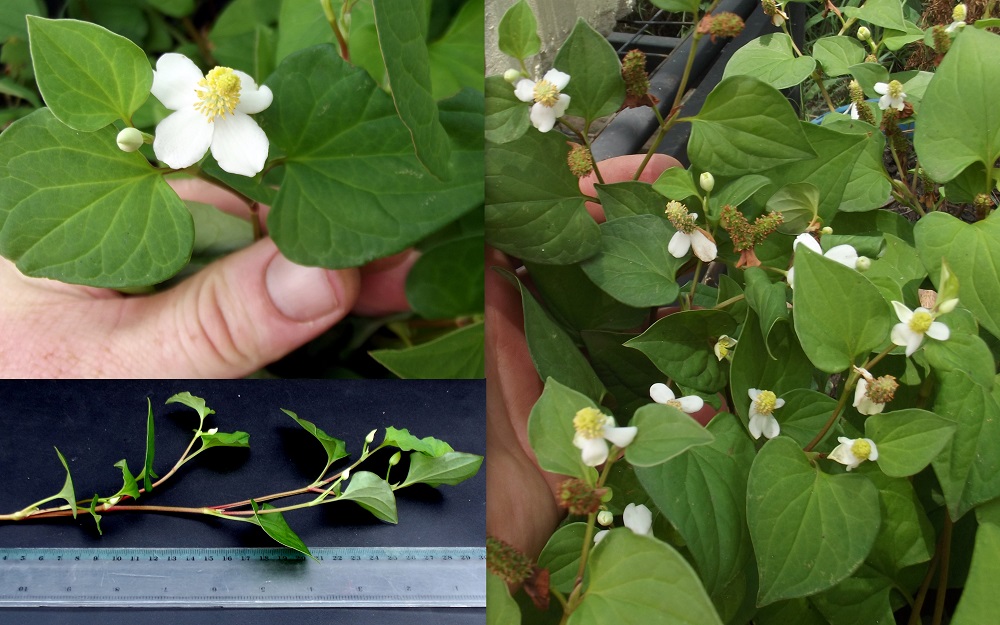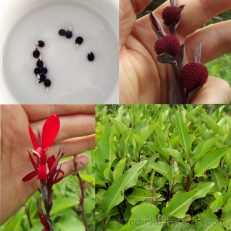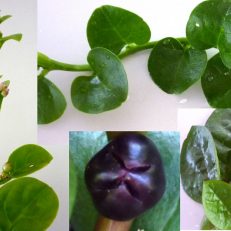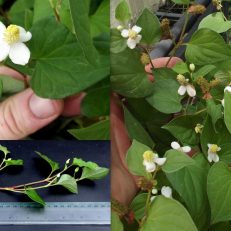Please read text!
Dokudami Fish Mint Houttuynia Cordata Cuttings
Packet containing at least 2x freshly dug, well rooted, ready to plant cuttings!
There are two main types and this is the traditionally used Japanese form that has a hint of citrus to its fishy smell. Most commonly called Dokudami or Fish mint, this plant is also known as Houttuynia oetida, Houttuynia emeiensis, Polypara ochinchinensis, pinyin, doku dami, yuxing cao, giap ca, pak kao tong, ja mardoh, tongko, masunduri, zheergen and many other regional names. I will select two nice sized cuts each with a section of white root, wrap in wet paper, put it in a bubble mailer and post them out to you guys standard mail. On arrival just shove them in a nice well draining sandy soil mix, put in a cool shady spot and water it.
If you do a quick Google you will find heaps of data about its use as a Food, as a well respected Medicine, and even as a Weed.
Let’s get the “weeds” bit out of the way first so I don’t get any angry emails. This plant is super tough, and in moister areas down south it really can be weedy, and it IS a problem in a lot of places overseas when not managed responsibly, especially the ornamental variegated “Chameleon” form that I do not grow. Here in Queensland when I planted this fella out it died as I didn’t water it consistently, but that doesn’t mean it won’t get away from you if planted out into the garden in nicer soil and moister conditions, so my advice is just don’t. There really isn’t any reason to, as it grows so well in pots. We get heaps from just a few pots, more than us and the chooks and guinea pigs could ever eat.
It does not grow from seeds, so as long as you keep it in a pot or tub it can not physically escape. It is a mint type of plant, it’s not a bloody triffid…..
If you ever do get too much and want to kill it, do not dump it in the bush or the local tip or compost it fresh and green, unless you can really keep the heat up. Just dry it in the sun for a couple days (just on the lawn or driveway is fine), then shove it in a bucket of water and keep it submerged for a week or two. Makes a great activator for compost heaps and is full of nutrition and minerals that your plants will benefit from as a tea. Once fully dried or rotted it dies, so if you do both there is no chance of any survivors.
Propagation. For ok growth plant the two cutting I send you just in a standard potting mix, leaf tip up with half the cutting under the soil, and water every couple days. That’s it. In a month or so it will have rooted and away you go.
For super fast growth plant the two cutting shallowly at an angle in a large pots full of 50% sand and 50% good rich compost packed soil, and sit the pots in a dish of water a couple cm deep. Water daily and that’s it. In a few weeks it will have rooted and away you go. If you want lots of growth give the odd feed with fish emulsion of seaweed extract, and water often.
Moist raised beds and wicking systems the growth is massive, much more than is practical and for that reason I do NOT recommend it. Trust me, a couple pots is plenty for most folks.
Alrighty, on to eating it.
It is grown throughout Asia as a leaf and root vegetable, particularly in Japan, Korea, China, Vietnam, Malaysia, and India. It smells like a combination of fresh fish, mint and citrus, and has large amounts of the aromatic chemicals myrcene and undecanone.
These and many other naturally occurring chemicals are the basis of its huge list of medicinal uses.
Famed as an antibacterial, and is used extensively by Chinese scientists to tackle SARS, as it is conventionally used to treat pneumonia, abnormal lung symptoms, infectious disease, refractory hemoptysis, and malignant pleural effusion. Widely used as a tea in Japan as a general detoxification for ridding the body of harmful bacteria, and in Nepal the juice from the roots is used for treating indigestion.
Applied to the skin to treat wounds, sores, carbuncles, and fungal diseases, it is used internally for inflammation of the urinary tract or infections. Dokudami apparently means “poison-blocking plant” in some cultures, and was often used as such. When you’re allergic to a substance, your body produces histamine, a compound that initiates an immune response. Studies have demonstrated that dokudami has inhibitory effects on histamine release, possibly blocking it and reducing its effects.
Well there you have it.
Another awesome, rare, but super easy to grow plant.
Grown by me and the Mrs organically, no chems no nasties no problems!!!





